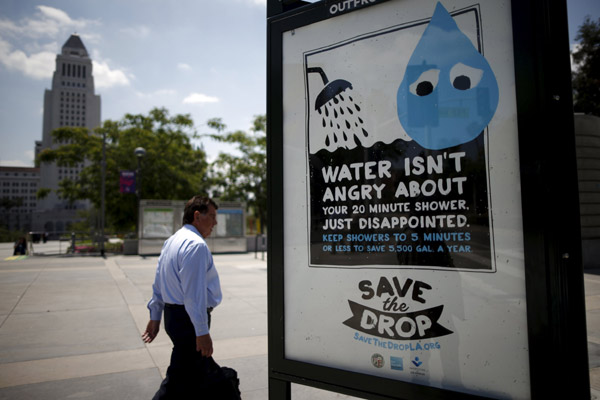 |
|
A man walks past a drought poster in Los Angeles, California, United States May 19, 2015. California water regulators have adopted the state's first rules for mandatory cutbacks in urban water use as the region's catastrophic drought enters its fourth year. Some communities will be required to trim water use by as much as 36 percent. [Photo/Agencies] |
MELBOURNE - Researchers in the drought-ravaged state of California are turning to Melbourne to learn more about effective strategies to combat drought, especially water- saving techniques.
California is suffering through one of its most severe dry periods on record, and researchers have found that strategies enacted in Melbourne during the Victorian drought that ended in 2010 were successful and could be transplanted to the United States.
Dr Andrew Hamilton, from the School of Veterinary and Agricultural Sciences at the University of Melbourne, said California was similar to Melbourne in terms of climate, so the strategies which worked so well in Victoria could be successful if transplanted across the Pacific.
"California goes through periods of drought and has a similar climate overall, so when we put it and Melbourne alongside each other, we found Melbourne had adopted more strategies to combat drought," he told Xinhua in an interview on Monday.
The paper he co-wrote, titled "Fighting drought with innovation: Melbourne's response to the Millennium Drought in Southeast Australia" was published in the scientific journal, WIREs, and indicated that some Californian residents were using up to 1313 liters every day, more than eight times more than the average Melburnian.
He said California's water shortage was an amalgamation of poor regulation and a vastly different cultural stance on saving water.
"The main reason it is happening is that from a regulatory perspective they just didn't enact the same controls as we have here in Melbourne," Hamilton said.
"It's also cultural, whereas in Australia, we are very used to the concept of drought and we realize we just had to let some things go, such as gardens."
Hamilton said Melbourne's water restriction regime helped cut the average daily water use in half between 1997 and 2010, while California had no restrictions before this year: "There were no restrictions in California, particularly compulsory restrictions like in Melbourne where you had to follow them otherwise you would get in trouble."
"California has only just this year brought in mandatory restrictions, before that they had voluntary restrictions, a concept which is a bit of an oxymoron."
The Victorian government used the media to spread awareness of the dire situation during the region's last drought, and while it might not have struck fear into the hearts of Melburnians, it served to raise awareness.
Daily updates of the state's dwindling reservoir levels and television ads encouraging shorter showers made restrictions a daily topic of conversation, and Hamilton said it actively changed the culture around saving water in Melbourne.
"Compared to similar countries in terms of development status, we do a very good job. Not only by enforcing water restrictions but by education campaigns and community targets, like the 'Target 155' campaign," he told Xinhua.
The Target 155 campaign encouraged Melburnians to use just 155 liters per day during the height of the drought, by banning residents from watering their gardens, strongly encouraging two minute showers and restricting car washes undertaken at home to just a bucket of water and not a running hose.
There were also government campaigns that encouraged residents to use the "half flush" function on toilets and only turn on dishwashers and washing machines when full.
Hamilton said a similar culture change in the United States would not take long if properly enacted.
"It actually doesn't take as long as one might think. Droughts are quite sudden and that 'Target 155' campaign was almost immediate in its effectiveness," he said.
"You might be talking a year or so to really get things underway, but that's one good thing about public outreach campaigns.
"That being said, there is the risk that you haven't really influenced the public consciousness properly. Whether it lasts is a different thing."
The paper was funded by the U.S. National Science Foundation, and was written as a collaboration between UC Irvine, the University of Melbourne, Federation University Australia and local water body Yarra Valley Water.